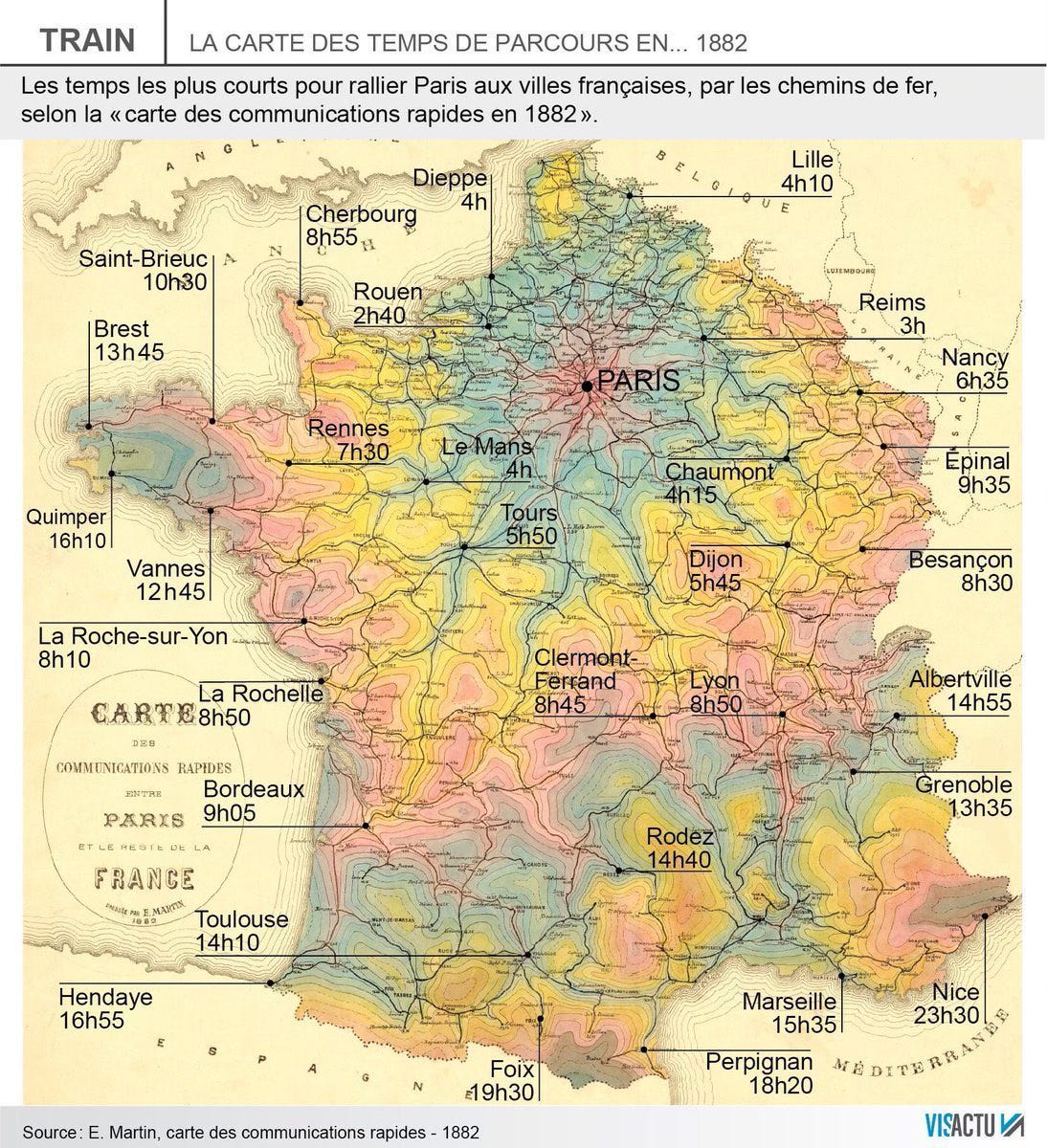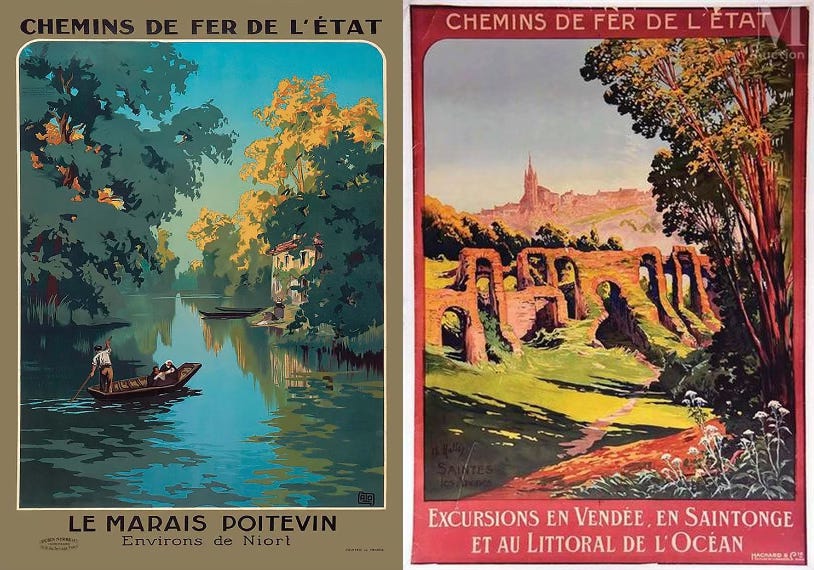In the July 1907 edition of the prominent weekly French magazine L’Illustration, journalist and writer Jean Cervin takes the reader on a journey through France [1]. The ultimate destination? Royan1 - a popular summer getaway for Parisians in the years leading up to WWI, known for its mild climate, beautiful beaches, and upscale seaside resorts.
During the famed Belle Époque, a time of industrialization and urban growth, expanding railway lines spurred the rise of seaside tourism. Starting in England, the trend of domesticating the beach and turning it into a place for thalassotherapy (sea therapy) had reached the French Atlantic coast at the start of the 1800s. Over the course of the century, seaside activities - such as taking in fresh air and sea baths - shifted away from health and more towards leisure, enjoyment, rest and relaxation.
Although the wealthy were already vacationing by train, by 1875, improvements in rail service made the trip from Paris to the southwestern coast rather quick, at under 10 hours. Soon, an influx of upper-class visitors - mainly the bourgeoisie from Bordeaux and Paris - led to the rise of casinos, theaters, trams, & rapid urban development in places like Royan. [2].
By the 1880s, third-class travelers were able to take day-trips with circular tickets that allowed for multiple stops. They enthusiastically boarded these trains de plaisir, or pleasure trains - for dedicated excursions at reduced rates of 40-70% - to destinations like Deauville, Nice, Biarritz, and Cannes.
Suddenly, everyone could “enjoy wandering for a few hours in lazily picturesque, somewhat hidden corners” [1], just like the early 20th century itinerary we’re following (to which I’m adding commentary).
Saumur and Montreuil-Bellay
Four hours from Paris, the first two stops lie in the heart of the Loire Valley, a region celebrated for its vineyards. The highlight is Saumur, a city shaped by the two rivers that encircle it, its châteaux and churches, and its renowned AOC-designated sparkling and red wines. These qualities have earned it a place in the works of Balzac, Voltaire, and Victor Hugo.
Montreuil-Bellay is part of the Saumur Attraction Area2, which is composed of 31 towns. The city has 17 historical sites to explore - including its famous Château de Montreuil-Bellay - on the banks of the Thouet River.
Niort and Saintes
A few hours southwest from Saumur, we arrive at the historical Poitou-Charentes area. Despite its small size in 1907, Niort and the surrounding Poitevin Marsh3 drew significant attention in the 19th century, with both Napoleon and King Louis-Philippe ordering extensive public works to develop the marshlands through canals and drainage systems.
In the 1870s and 80s, mutual insurance companies started forming to support agricultural workers and small businesses, and it would eventually turn Niort into France’s fourth most important financial center.
Tourists could explore city’s Romanesque twin dungeons, visit Les Halles de Niort - a historic covered market built from iron and steel, inspired by the famous Halles of Paris - ride through the calm canals of the nearby marsh, or perhaps even catch a glimpse of an automobile, as Niort was home to Automobiles Barré4, one of France's pioneering car makers.
As for Saintes, it was the regional seat of the French state-owned railway company, making it an obvious stop on the way to the seaside. Tourist activities also abound here, especially in terms of Roman era constructions and ruins5.
But, alas, it’s time to catch the final short stretch of rail to our destination.
Royan’s rise, fall & rebirth
Situated at the mouth of the Gironde estuary - the largest estuary in Europe - Royan was always an attractive site, but also open to siege. It was subject to Visigoth invasions and Viking incursions, and was destroyed by Louis XIII during the Wars of Religion in the early 17th century. During the Restoration, after the fall of Napoleon, Royan finally had some respite from ruin, and began to be known a place of repose.
Royan experienced an era of grand villas and elegant promenades, along with its aforementioned mild climate and beautiful beaches that intermingle with five limestone cliffs - locally known as conches. And if the seaside isn’t of interest, the city is surrounded by the Pontaillac, Pousseau and Belmont marshes, with the latter two being special protection areas for 31 bird species.
Future generations would find another city in its place. During the Allied bombings in 1945, over 85% of Royan was destroyed, including its town center, its historic buildings, harbor and beachside6. Far from an isolated incident, the same occurred with Dunkirk, Toulon, Le Havre, Saint-Dié and Calais. The collective rebuilding of these seaside towns was deemed an "urban planning research laboratory".
The rebuilding of Royan itself was supposed to adhere to a regional Saintongeais style of architecture and urban design but Brazilian modernism, filtered through Le Corbusier, took hold in the city. By the early 1950s, elements such as brise-soleils, curved forms, and indoor-outdoor integration transformed the city’s architecture, replacing older 19th-century features with something avant-garde [4, 5].
Today, Royan offers much for the modern visitor: a blend of sport and relaxation, culture and nature, urban beaches and the Atlantic coast, oyster marshes and vineyard hillsides, Romanesque heritage & 50s architecture [6].
In 2010, it was classified as protected cultural heritage status, or a Town of Art and History (Ville d’Art et d’Histoire). These days, it attracts around 700,000 yearly visitors, generating 172 million of the region’s 430 million euros [7].
The city's evolving narrative mirrors the experience of a train journey through time, where one moment you’re aboard a runaway train, the next you’re taking a leisurely ride on one of France’s classic tourist trains, revisiting its past. One thing is for sure, if the historical journey of Royan were itself a train ride, its stations would require passengers to switch trains, alternating between these two paths. Luckily, readers can skip the runaway kind7.
Additional Information
1 - Le peuple, grâce aux chemins de fer, apparaît enfin sur « les plages saines et vivifiantes »
2 - Un âge d’or du chemin de fer français : a-t-il existé et quand?
3 - Un aspect du voyage en chemin de fer: le voyage d'agrément sur le réseau de l'Ouest des années 1830 aux années 1880
Sources
1 - L’illustration (pg 11), or simply here.
2 - François and the Atlas Mountain: "Royan"
3 - Les affiches touristiques
4 - L’invention du balnéaire « cinquante » à Royan
5 - La reconstruction de Royan
6 - Royan Atlantique Tourist Office (& online guide books)
7 - Royan and its festivals
on the Atlantic coast, between Nantes & Bordeaux
such an area defines the extent of a municipality's influence on its surroundings
known as the Green Venice
Only the neighborhoods located to the west, on the Pontaillac side, and to the east along the Grande Conche, are partially spared.
Trains touristiques (France) & Trains de Mouettes (Royan region)








